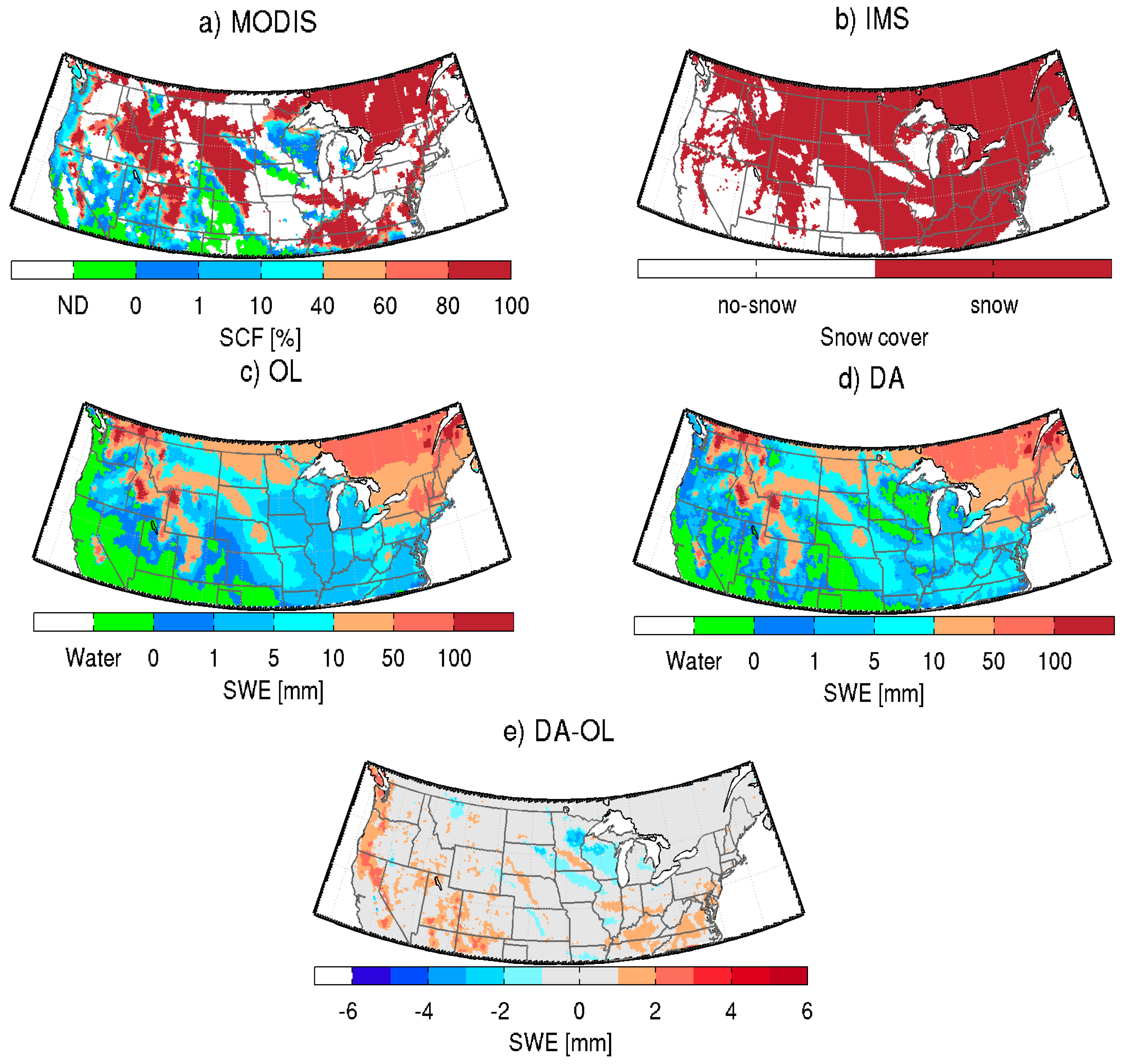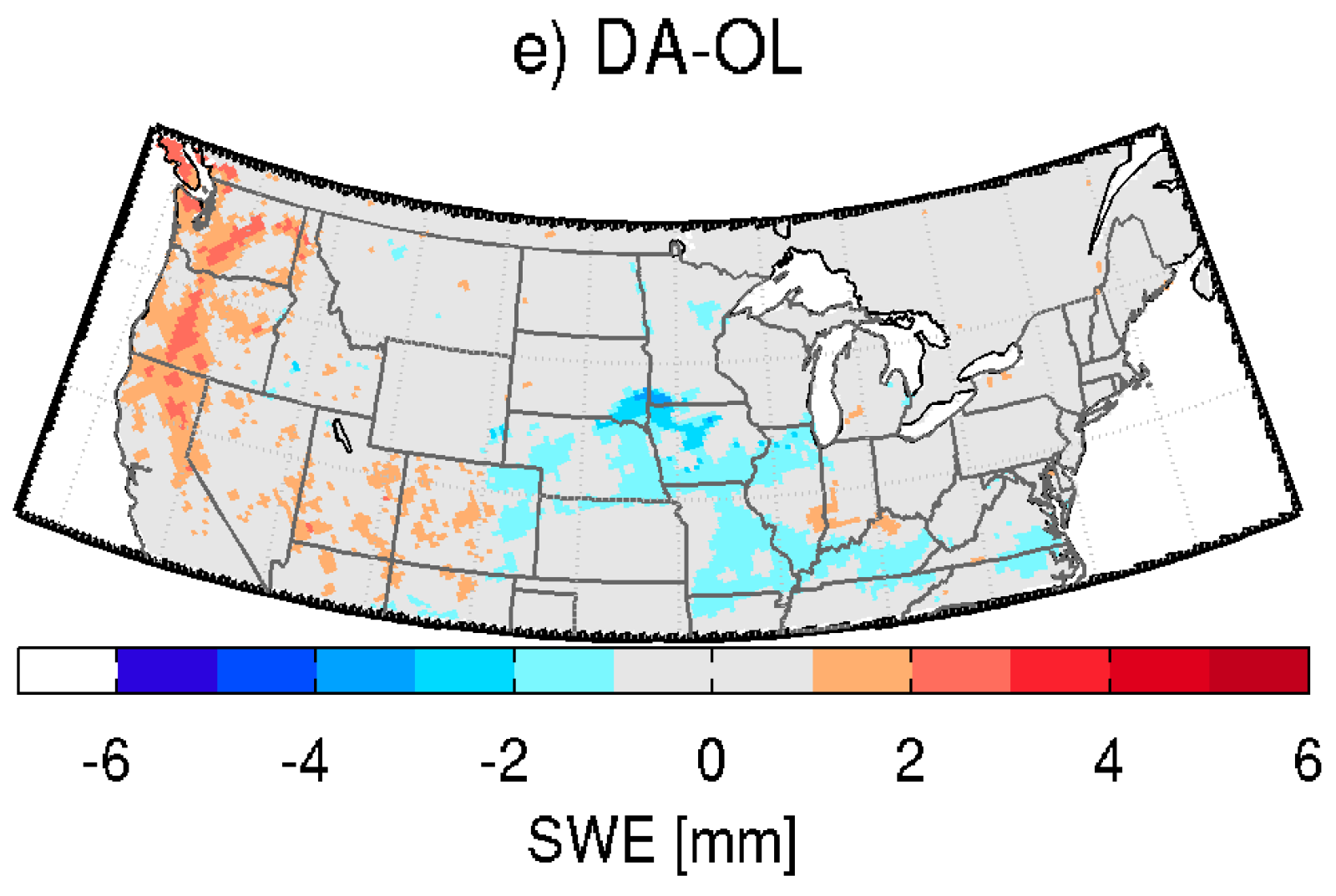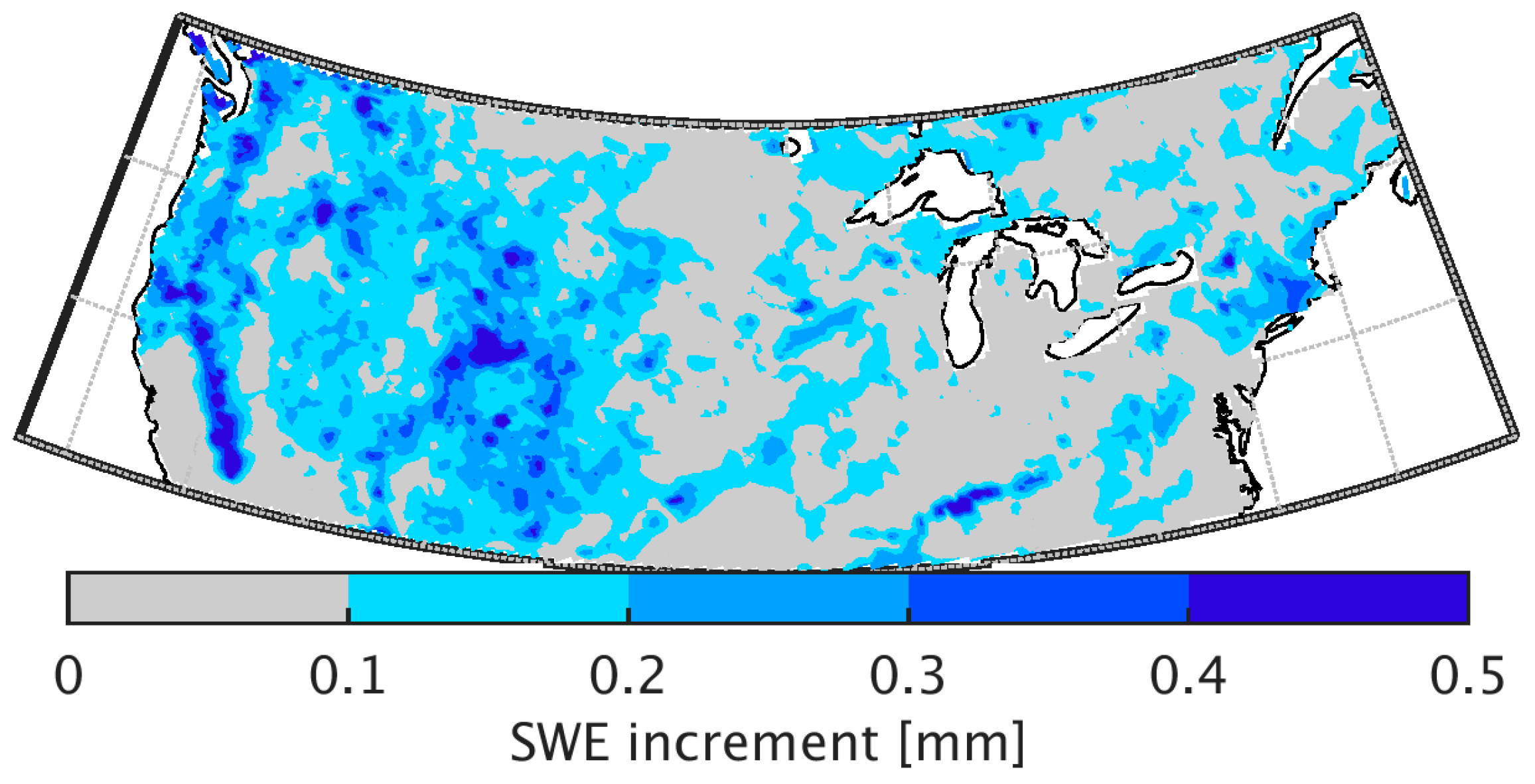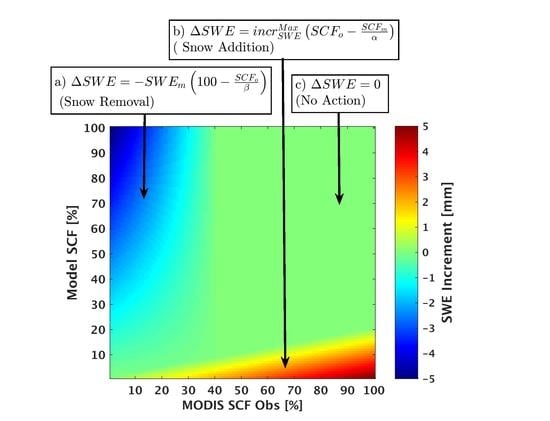Assimilation of MODIS Snow Cover Fraction Observations into the NASA Catchment Land Surface Model
Abstract
:1. Introduction
2. Model and Data
2.1. Model Description
2.2. MODIS Snow Cover Fraction Observations
2.3. Evaluation of CLSM-MERRA and CLSM-MLand Snow Cover
3. Assimilation Algorithm
4. Evaluation Datasets and Approach
4.1. Evaluation Datasets
4.1.1. Canadian Meteorological Centre (CMC) Daily Snow Depth Analysis Data
4.1.2. Interactive Multisensor Snow and Ice Mapping System Snow Cover
4.1.3. Snow Telemetry (SNOTEL) Observations
4.2. Evaluation Approach
5. Results and Discussion
5.1. Comparison between IMS Snow Cover Product and Assimilated Snow Cover Fraction
5.2. Comparison between Canadian Meteorological Centre (CMC) Snow Depth and Water Equivalent (SWE) and Model Estimates
5.3. Comparison between SNOTEL SWE Measurements and Model Estimates of SWE
5.4. Assimilation Increments
5.5. Sensitivity Analysis
6. Summary and Conclusions
Acknowledgments
Author Contributions
Conflicts of Interest
References
- Kukla, G. Snow Covers and Climate: Glaciological Data; Report GD-11 (Snow Watch 1980); World Data Center A for Glaciology (Snow and Ice): Boulder, CO, USA, 1981; pp. 27–39. [Google Scholar]
- Cohen, J.; Rind, D. The effect of snow cover on the climate. J. Clim. 1991, 4, 689–706. [Google Scholar] [CrossRef]
- Hare, F.K.; Thomas, M.K. Climate Canada, 2nd ed.; John Wiley and Sons Canada Limited: Toronto, ON, Canada, 1979; p. 230. [Google Scholar]
- Walsh, J.E.; Tucek, D.R.; Peterson, M.R. Seasonal snow cover and short-term climatic fluctuations over the United States. Mon. Weather Rev. 1982, 110, 1474–1485. [Google Scholar] [CrossRef]
- Walsh, J.E.; Jasperson, W.H.; Ross, B. Influences of snow cover and soil moisture on monthly air temperature. Mon. Weather Rev. 1985, 113, 756–769. [Google Scholar] [CrossRef]
- Dingman, S.L. Physical Hydrology, 2nd ed.; Prentice Hall: Upper Saddle River, NJ, USA, 2002; p. 646. [Google Scholar]
- Brown, R.D. Northern Hemisphere snow cover variability and change, 1915–97. J. Clim. 2000, 13, 2339–2355. [Google Scholar] [CrossRef]
- Lemke, P.; Ren, J.; Alley, R.B.; Allison, I.; Carrasco, J.; Flato, G.; Fujii, Y.; Kaser, G.; Mote, P.; Thomas, R.H.; et al. Observations: Changes in Snow, Ice and Frozen Ground. In Climate Change 2007: The Physical Science Basis; Contribution of Working Group I to the Fourth Assessment Report of the Intergovernmental Panel on Climate Change; Solomon, S.D., Qin, M., Manning, Z., Eds.; Cambridge University Press: Cambridge, UK; New York, NY, USA, 2007. [Google Scholar]
- Derksen, C.; Brown, R. Spring snow cover extent reductions in the 2008–2012 period exceeding climate model projections. Geophys. Res. Lett. 2012, 39. [Google Scholar] [CrossRef]
- Pagano, T.; Garen, D. A Recent Increase in Western US Streamflow Variability and Persistence. J. Hydrometeorol. 2005, 6, 173–179. [Google Scholar] [CrossRef]
- Yarnell, S.M.; Viers, J.H.; Mount, J.F. Ecology and Management of the Spring Snowmelt Recession. BioScience 2010, 60, 114–127. [Google Scholar] [CrossRef]
- Niu, G.-Y.; Yang, Z.-L. An observation-based formulation of snow cover fraction and its evaluation over large North American river basins. J. Geophys. Res. 2007, 112, D21101. [Google Scholar] [CrossRef]
- Roesch, A.; Wild, M.; Gilgen, H.; Ohmura, A. A new snow cover fraction parameterization for ECHAM4 GCM. Clim. Dyn. 2001, 17, 933–946. [Google Scholar]
- Cortés, G.; Girotto, M.; Margulis, S.A. Analysis of sub-pixel snow and ice extent over the extratropical Andes using spectral unmixing of historical Landsat imagery. Remote Sens. Environ. 2014, 141, 64–78. [Google Scholar] [CrossRef]
- Kunzi, K.F.; Patil, S.; Rott, H. Snow-cover parameters retrieval from Nimbus-7 scanning multichannel microwave radiometer (SMMR) data. IEEE Trans. Geosci. Remote Sens. 1982, 4, 452–467. [Google Scholar] [CrossRef]
- Chang, A.T.C.; Foster, J.L.; Hall, D.K. Nimbus-7 SMMR derived global snow cover Parameters. Ann. Glaciol. 1987, 9, 39–44. [Google Scholar] [CrossRef]
- Dozier, J. Spectral signature of alpine snow cover from the Landsat Thematic Mapper. Remote Sens. Environ. 1989, 28, 9–22. [Google Scholar] [CrossRef]
- Rosenthal, W.; Dozier, J. Automated mapping of montane snow cover at subpixel resolution from the Landsat Thematic Mapper. Water Resour. Res. 1996, 32, 115–130. [Google Scholar] [CrossRef]
- Baglio, J.V.; Holroyd, E.W. Methods for Operational Snow Cover Area Mapping Using the Advanced Very High Resolution Radiometer: San Juan Mountains Test Study, 1989; Research Technical Report; U.S. Geological Survey: Sioux Falls, SD, USA; U.S. Bureau of Reclamation: Denver, CO, USA, 1989.
- Hall, D.K.; Salomonson, V.V.; Riggs, G.A. MODIS/Terra Snow Cover Daily L3 Global 0.058 CMG; Version 5; NASA National Snow and Ice Data Center Distributed Active Archive Center: Boulder, CO, USA, 2006.
- Baumgartner, M.F.; Seidel, K.; Martinec, J. Toward snowmelt runoff forecast based on multisensor remote-sensing information. IEEE Trans. Geosci. Remote Sens. 1987, 6, 746–750. [Google Scholar] [CrossRef]
- Hall, D.K.; Andrew, B.T.; James, L.F.; Chang, A.T.C.; Milan, A. Intercomparison of satellite-derived snow-cover maps. Ann. Glaciol. 2000, 31, 369–376. [Google Scholar] [CrossRef]
- Armstrong, R.L.; Brodzik, M.J. Recent Northern Hemisphere snow extent: A comparison of data derived from visible and microwave satellite sensors. Geophys. Res. Lett. 2001, 28, 3673–3676. [Google Scholar] [CrossRef]
- Bitner, D.; Carroll, T.; Cline, D.; Romanov, P. An assessment of the differences between three satellite snow cover mapping techniques. Hydrol. Process. 2002, 16, 3723–3733. [Google Scholar] [CrossRef]
- Rango, A.; Landesa, E.G.; Bleiweiss, M. Comparative satellite capabilities for remote sensing of snow cover in the Rio Grande basin. In Proceedings of the 70th Western Snow Conference, Sol Vista, CO, USA, 20–23 May 2002; pp. 21–26. [Google Scholar]
- Klein, A.G.; Barnett, A.C. Validation of daily MODIS snow cover maps of the Upper Rio Grande river basin for the 2000–2001 snow year. Remote Sens. Environ. 2003, 86, 162–176. [Google Scholar] [CrossRef]
- Maurer, E.P.; Rhoads, J.D.; Dubayah, R.O.; Lettenmaier, D.P. Evaluation of the snow-covered area data product from MODIS. Hydrol. Process. 2003, 17, 59–71. [Google Scholar] [CrossRef]
- Rango, A.; Landesa, E.G.; Bleiweiss, M.; Havstad, K.; Tanksley, K. Improved satellite snow mapping, snowmelt runoff forecasting, and climate change simulations in the Upper Rio Grande basin. World Resour. Rev. 2003, 15, 26–41. [Google Scholar]
- Painter, T.H.; Dozier, J.; Roberts, D.A.; Davis, R.E.; Green, R.O. Retrieval of subpixel snow-covered area and grain size from imaging spectrometer data. Remote Sens. Environ. 2003, 85, 64–77. [Google Scholar] [CrossRef]
- Andreadis, K.; Lettenmaier, D. Assimilating remotely sensed snow observations into a macroscale hydrology model. Adv. Water Resour. 2006, 29, 872–886. [Google Scholar] [CrossRef]
- Painter, T.H.; Rittger, K.; Mckenzie, C.; Slaughter, P.; Davis, R.E.; Dozier, J. Retrieval of subpixel snow covered area, grain size, and albedo from MODIS. Remote Sens. Environ. 2009, 113, 868–879. [Google Scholar] [CrossRef]
- Rittger, K.; Painter, T.H.; Dozier, J. Assessment of methods for mapping snow cover from MODIS. Adv. Water Resour. 2013, 51, 367–380. [Google Scholar] [CrossRef]
- McLaughlin, D.B. An integrated approach to hydrologic data assimilation: Interpolation, smoothing, and filtering. Adv. Water Resour. 2002, 25, 1275–1286. [Google Scholar] [CrossRef]
- Reichle, R.H.; Bosilovich, M.G.; Crow, W.T.; Koster, R.D.; Kumar, S.V.; Mahanama, S.P.P.; Zaitchik, B.F. Recent Advances in Land Data Assimilation at the NASA Global Modeling and Assimilation Office. In Data Assimilation for Atmospheric, Oceanic and Hydrologic Applications; Park, S.K., Xu, L., Eds.; Springer Verlag: New York, NY, USA, 2009; pp. 407–428. [Google Scholar]
- Rodell, M.; Houser, P.R. Updating a land surface model with MODIS-derived snow cover. J. Hydrometeorol. 2004, 5, 1064–1075. [Google Scholar] [CrossRef]
- Zaitchik, B.F.; Rodell, M. Forward-looking assimilation of MODIS-derived snow-covered area into a land surface model. J. Hydrometeorol. 2009, 10, 130–148. [Google Scholar] [CrossRef]
- De Lannoy, G.J.M.; Reichle, R.H.; Arsenault, K.R.; Houser, P.R.; Kumar, S.; Verhoest, N.E.C.; Pauwels, V.R.N. Multiscale assimilation of Advanced Microwave Scanning Radiometer–EOS snow water equivalent and Moderate Resolution Imaging Spectroradiometer snow cover fraction observations in northern Colorado. Water Resour. Res. 2012, 48. [Google Scholar] [CrossRef]
- Arsenault, K.R.; Houser, P.R.; De Lannoy, G.J.M.; Dirmeyer, P.A. Impacts of snow cover fraction data assimilation on modeled energy and moisture budgets. J. Geophys. Res. Atmos. 2013, 118, 7489–7504. [Google Scholar] [CrossRef] [Green Version]
- Zhang, Y.-F.; Hoar, T.; Yang, Z.-L.; Anderson, J.; Toure, A.M.; Rodell, M. Assimilation of MODIS Snow Cover through the Data Assimilation Research Testbed and the Community Land Model version 4. J. Geophys. Res. Atmos. 2014, 119, 7091–7103. [Google Scholar] [CrossRef]
- Girotto, M.; Cortes, G.; Margulis, S.A.; Durand, M. Examining spatial and temporal variability in snow water equivalent using a 27 year reanalysis: Kern River watershed, Sierra Nevada. Water Resour. Res. 2014, 50, 6713–6734. [Google Scholar] [CrossRef]
- Girotto, M.; Margulis, S.A.; Durand, M. Probabilistic SWE reanalysis as a generalization of deterministic SWE reconstruction techniques. Hydrol. Process. 2014, 28, 3875–3895. [Google Scholar] [CrossRef]
- Kumar, S.V.; Peters-Lidard, C.D.; Arsenault, K.R.; Getirana, A.; Mocko, D.; Liu, Y. Quantifying the added value of snow cover area observations in passive microwave snow depth data assimilation. J. Hydrometeorol. 2015, 16, 1736–1741. [Google Scholar] [CrossRef]
- Margulis, S.; Girotto, M.; Cortés, G.; Durand, M. A particle batch smoother approach to snow water equivalent estimation. J. Hydrometeorol. 2015, 16, 1752–1772. [Google Scholar] [CrossRef]
- Zhang, Y.-F.; Yang, Z.-L. Estimating uncertainties in the newly developed multi-source land snow data assimilation system. J. Geophys. Res. Atmos. 2016, 121, 8254–8268. [Google Scholar] [CrossRef]
- Charrois, L.; Cosme, E.; Dumont, M.; Lafaysse, M.; Morin, S.; Libois, Q.; Picard, G. On the assimilation of optical reflectances and snow depth observations into a detailed snowpack model. Cryosphere 2016, 10, 1021–1038. [Google Scholar] [CrossRef]
- Margulis, S.A.; Cortés, G.; Girotto, M.; Huning, L.S.; Li, D.; Durand, M. Characterizing the extreme 2015 snowpack deficit in the Sierra Nevada (USA) and the implications for drought recovery. Geophys. Res. Lett. 2016, 43, 6341–6349. [Google Scholar] [CrossRef]
- Koster, R.D.; Suarez, M.J. Modeling the land surface boundary in climate models as a composite of independent vegetation stands. J. Geophys. Res. Atmos. 1992, 97, 2697–2715. [Google Scholar] [CrossRef]
- Evensen, E. Sequential data assimilation with nonlinear quasi-geostrophic model 803 using Monte Carlo methods to forecast error statistics. J. Geophys. Res. Oceans 1994, 99, 10143–10162. [Google Scholar] [CrossRef]
- Reichle, R.H.; McLaughlin, D.B.; Entekhabi, D. Hydrologic data assimilation with the Ensemble Kalman filter. Mon. Weather Rev. 2002, 130, 103–114. [Google Scholar] [CrossRef]
- Reichle, R.H.; Walker, J.P.; Koster, R.D.; Houser, P.R. Extended vs. Ensemble Kalman Filtering for Land Data Assimilation. J. Hydrometeorol. 2002, 3, 728–740. [Google Scholar] [CrossRef]
- Ek, M.; Mitchell, K.; Yin, L.; Rogers, P.; Grunmann, P.; Koren, V.; Gayno, G.; Tarpley, J.D. Implementation of Noah land surface model advances in the NCEP operational mesoscale Eta model. J. Geophys. Res. Atmos. 2003, 108, 8851. [Google Scholar] [CrossRef]
- Lawrence, D.M.; Oleson, K.W.; Flanner, M.G.; Thornton, P.E.; Swenson, S.C.; Lawrence, P.J.; Zeng, X.; Yang, Z.-L.; Levis, S.; Sakaguchi, K.; et al. Parameterization Improvements and Functional and Structural Advances in Version 4 of the Community Land Model. J. Adv. Model. Earth Syst. 2011, 3. [Google Scholar] [CrossRef]
- Kluzek, E. CESM Research Tools: CLM4 in CESM1.0.4 User’s Guide Documentation; National Centers for Atmospheric Research: Boulder, CO, USA, 2012.
- Cortés, G.; Girotto, M.; Margulis, S. Snow process estimation over the extratropical Andes using a data assimilation framework integrating MERRA data and Landsat imagery. Water Resour. Res. 2016, 52, 2582–2600. [Google Scholar] [CrossRef]
- Koster, R.D.; Suarez, M.J.; Ducharne, A.; Stieglitz, M.; Kumar, P. A catchment-based approach to modeling land surface processes in a GCM, Part 1, Model Structure. J. Geophys. Res. Atmos. 2000, 105, 24809–24822. [Google Scholar] [CrossRef]
- Ducharne, A.; Koster, R.D.; Suarez, M.J.; Stieglitz, M.; Kumar, P. A catchment-based approach to modeling land surface processes in a GCM, Part 2, Parameter estimation and model demonstration. J. Geophys. Res. Atmos. 2000, 105, 24823–24838. [Google Scholar] [CrossRef]
- Rienecker, M.M.; Suarez, M.J.; Gelaro, R.; Todling, R.; Bacmeister, J.; Liu, E.; Bosilovich, M.G.; Schubert, S.D.; Takacs, L.; Kim, G.-K.; et al. MERRA: NASA’s Modern-Era Retrospective Analysis for Research and Applications. J. Clim. 2011, 24, 3624–3648. [Google Scholar] [CrossRef]
- Reichle, R.; Koster, D.; De Lannoy, G.J.M.; Forman, B.A.; Liu, Q.; Mahanama, S.P.P.; Toure, A.M. Assessment and Enhancement of MERRA Land Surface Hydrology Estimates. J. Clim. 2011, 24, 6322–6338. [Google Scholar] [CrossRef] [Green Version]
- Gelaro, R.; McCarty, W.; Suárez, M.J.; Todling, R.; Molod, A.; Takacs, L.; Randlesa, C.A.; Darmenova, A.; Bosilovicha, M.G.; Reichlea, R.; et al. The Modern-Era Retrospective Analysis for Research and Applications, Version 2 (MERRA-2). J. Clim. 2017, 30, 5419–5454. [Google Scholar] [CrossRef]
- Reichle, R.H.; Draper, C.S.; Liu, Q.; Girotto, M.; Mahanama, S.P.P.; Koster, R.D.; De Lannoy, G.J.M. Assessment of MERRA-2 land surface hydrology estimates. J. Clim. 2017, 30, 2937–2960. [Google Scholar] [CrossRef]
- Stieglitz, M.; Ducharne, A.; Koster, R.D.; Suarez, M.J. The Impact of Detailed Snow Physics on the Simulation of Snowcover and Subsurface Thermodynamics at Continental Scales. J. Hydrometeorol. 2001, 3, 228–242. [Google Scholar] [CrossRef]
- Xie, J.E.; Janowiak, P.A.; Arkin, R.; Adler, A.; Gruber, R.; Ferraro, G.J.; Huffman, G.J.; Curtis, S. GPCP pentad precipitation analyses: An experimental dataset based on gauge observations and satellite estimates. J. Clim. 2003, 16, 2197–2214. [Google Scholar] [CrossRef]
- Huffman, G.J.; Adler, R.F.; Bolvin, D.T.; Gu, G. Improving the global precipitation record: GPCP version 2.1. Geophys. Res. Lett. 2009, 36, L17808. [Google Scholar] [CrossRef]
- Hall, D.K.; Riggs, G.A.; Salomonson, V.V. MODIS/Terra Snow Cover Daily L3 Global 0.05deg CMG V005; Digital Media (Updated Daily); National Snow and Ice Data Center: Boulder, CO, USA, 2006.
- Hall, D.K.; Riggs, G.A. Accuracy assessment of the MODIS snow-cover products. Hydrol. Process. 2007, 21, 1534–1547. [Google Scholar] [CrossRef]
- Riggs, G.A.; Hall, D.K. Improved snow mapping accuracy with revised MODIS snow algorithm. In Proceedings of the 69th Annual Eastern Snow Conference, New York, NY, USA, 5–7 June 2012. [Google Scholar]
- Brasnett, B. A global analysis of snow depth for Numerical Weather Prediction. J. Appl. Meteorol. 1999, 38, 726–740. [Google Scholar] [CrossRef]
- Brown, R.D.; Brasnett, B. Canadian Meteorological Centre (CMC) Daily Snow Depth Analysis Data, Environment Canada; Digital Media; National Snow and Ice Data Center: Boulder, CO, USA, 2010.
- Su, H.; Yang, Z.; Dickinson, R.E.; Wilson, C.R.; Niu, G.-Y. Multisensor snow data assimilation at continental scale: The value of Gravity Recovery and Climate Experiment terrestrial water storage information. J. Geophys. Res. Atmos. 2010, 115. [Google Scholar] [CrossRef]
- Forman, B.A.; Reichle, R.H.; Rodell, M. Assimilation of terrestrial water storage from GRACE in a snow-dominated basin. Water Resour. Res. 2012, 48. [Google Scholar] [CrossRef]
- Sturm, M.; Taras, B.; Liston, G.E.; Derksen, C.; Jonas, T.; Lea, J. Estimating snow water equivalent using snow depth data and climate classes. J. Hydrometeorol. 2010, 11, 1380–1394. [Google Scholar] [CrossRef]
- Helfrich, S.R.; McNamara, D.; Ramsay, B.H.; Baldwin, T.; Kasheta, T. Enhancements to, and forthcoming developments in the Interactive Multisensor Snow and Ice Mapping System (IMS). Hydrol. Process. 2007, 21, 1576–1586. [Google Scholar] [CrossRef]
- Romanov, P.; Gutman, G.; Csiszar, I. Automated monitoring of snow cover over North America with multispectral satellite data. J. Appl. Meteorol. 2000, 39, 1866–1880. [Google Scholar] [CrossRef]
- Serreze, M.C.; Clark, M.P.; Armstrong, R.L.; McGuiness, D.A.; Pulwarty, R.S. Characteristics of the western United States snowpack from snowpack telemetry (SNOTEL) data. Water Resour. Res. 1999, 35, 2145–2160. [Google Scholar] [CrossRef]
- Moloch, N.P.; Bales, R.C. SNOTEL representativeness in the Rio Grande headwaters on the basis of physiographics and remotely sensed snow cover persistence. Hydrol. Process. 2006, 20, 723–739. [Google Scholar] [CrossRef]
- Larson, K.M.; Gutmann, E.D.; Zavorotny, V.U.; Braun, J.J.; Williams, M.W.; Nievinski, F.G. Can we measure snow depth with GPS receivers? Geophys. Res. Lett. 2009, 36, L17502. [Google Scholar] [CrossRef]
- Toure, A.M.; Rodell, M.; Yang, Z.-L.; Beaudoing, H.; Kim, E.; Zhang, Y.-F.; Kwon, Y. Evaluation of the Snow Simulations from the Community Land Model version 4 (CLM4). J. Hydrometeorol. 2016, 17, 153–170. [Google Scholar] [CrossRef]
- Simpson, J.J.; Stitt, J.R.; Sienko, M. Improved estimates of the areal extent of snow cover from AVHRR data. J. Hydrol. 1998, 204, 1–23. [Google Scholar] [CrossRef]
- Peterson, D.H.; Smith, R.E.; Dettinger, M.D.; Cayan, D.R.; Riddle, L. An organized signal in snowmelt runoff over the western United States. J. Am. Water Res. Assoc. 2000, 36, 421–432. [Google Scholar] [CrossRef]
- Moser, C.L.; Tootle, G.A.; Oubeidillah, A.A.; Lakshmi, V. A comparison of SNOTEL and AMSR-E snow water equivalent data sets in Western US watersheds. Int. J. Remote Sens. 2011, 32, 6611–6629. [Google Scholar] [CrossRef]
- Pan, M.; Sheffield, J.; Wood, E.F.; Mitchell, K.E.; Houser, P.R.; Schaake, J.C.; Robock, A.; Lohmann, D.; Cosgrove, B.A.; Duan, Q.; et al. Snow Process Modeling in the North American Land Data Assimilation System (NLDAS). Part II: Evaluation of Model Simulated Snow Water Equivalent. J. Geophys. Res. 2003, 108, 8850. [Google Scholar] [CrossRef]
- Clow, D.W.; Nanus, L.; Verdin, K.L.; Schmidt, J. Evaluation of SNODAS snow depth and snow water equivalent estimates for the Colorado Rocky Mountains, USA. Hydrol. Process. 2012, 26, 2583–2591. [Google Scholar] [CrossRef]
- Fernandes, R.A.; Zhou, F.; Song, H. Evaluation of Multiple Datasets for Producing Snow-Cover Indicators for Canada; Geomatics Canada, open file; Natural Resources Canada: Sidney, BC, Canada, 2017; p. 30.
- Essery, R.; Pomeroy, J. Vegetation and topographic control of wind-blown snow distributions in distributed and aggregated simulations for an Arctic tundra basin. J. Hydrometeorol. 2004, 5, 735–744. [Google Scholar] [CrossRef]
- Glen, E.L.; Haehnel, R.B.; Sturm, M.; Hiemstra, C.A.; Berezovskaya, S.; Tabler, R.D. Simulating complex snow distributions in windy environments using SnowTran-3D. J. Glaciol. 2007, 53, 241–256. [Google Scholar] [CrossRef]
- Brown, R.D.; Brasnett, B.; Robinson, D. Gridded North American monthly snow depth and snow water equivalent for GCM evaluation. Atmos. Ocean 2003, 41, 1–14. [Google Scholar] [CrossRef]
- Goodison, B.E. Accuracy of Canadian Snow Gage Measurements. J. Appl. Meteorol. 1978, 17, 1542–1548. [Google Scholar] [CrossRef]
- Groisman, P.Y.; Peck, E.L.; Quayle, R.G. Intercomparison of Recording and Standard Nonrecording U.S. Gauges. J. Atmos. Ocean. Technol. 1999, 16, 602–609. [Google Scholar] [CrossRef]
- Decharme, B.; Douville, H. Global validation of the ISBA Sub-Grid Hydrology. Clim. Dyn. 2007, 29, 21–37. [Google Scholar] [CrossRef]
- Zhao, W.; Li, A. A review on land surface processes modelling over complex terrain. Adv. Meteorol. 2015, 2015, 607181. [Google Scholar] [CrossRef]











| MODIS Observations | |||
|---|---|---|---|
| Model | Snow | No snow | |
| Snow | a | b | |
| No snow | c | d | |
© 2018 by the authors. Licensee MDPI, Basel, Switzerland. This article is an open access article distributed under the terms and conditions of the Creative Commons Attribution (CC BY) license (http://creativecommons.org/licenses/by/4.0/).
Share and Cite
Toure, A.M.; Reichle, R.H.; Forman, B.A.; Getirana, A.; De Lannoy, G.J.M. Assimilation of MODIS Snow Cover Fraction Observations into the NASA Catchment Land Surface Model. Remote Sens. 2018, 10, 316. https://doi.org/10.3390/rs10020316
Toure AM, Reichle RH, Forman BA, Getirana A, De Lannoy GJM. Assimilation of MODIS Snow Cover Fraction Observations into the NASA Catchment Land Surface Model. Remote Sensing. 2018; 10(2):316. https://doi.org/10.3390/rs10020316
Chicago/Turabian StyleToure, Ally M., Rolf H. Reichle, Barton A. Forman, Augusto Getirana, and Gabrielle J. M. De Lannoy. 2018. "Assimilation of MODIS Snow Cover Fraction Observations into the NASA Catchment Land Surface Model" Remote Sensing 10, no. 2: 316. https://doi.org/10.3390/rs10020316







